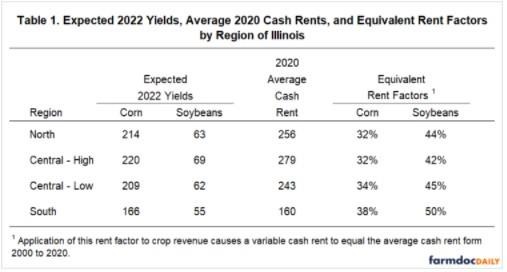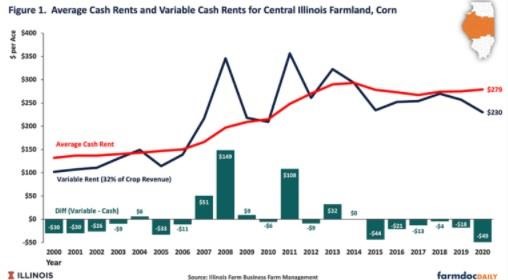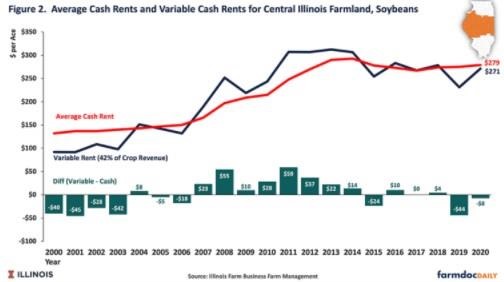By Gary Schnitkey and Nick Paulson et.al
Department of Agricultural and Consumer Economics
University of Illinois
Carl Zulauf
Department of Agricultural, Environmental and Development Economics
Ohio State University
Unlike fixed cash rental arrangements, payments from a variable cash rent arrangements will vary based on prices and yields. Often during times of changing commodity prices, there is a need to renegotiate cash rents. Recent increases in commodity prices suggest that many rents will be re-negotiated this year, likely at higher levels. The use of a variable cash rental arrangement reduces renegotiation pressures. One barrier to the use of variable cash rents is specifying the parameters of variable cash rent. We present one of the most straightforward variable cash rental agreements in this article, with parameters set so that historical rents from the variable cash rent will equal average cash rents.
Terms of the Variable Cash Rent
This cash rental arrangement will base cash rents on percentages of crop revenues unless the result of those calculations is below a minimum cash rent. The percent of crop revenue is called the rent factor. Important terms of this share rent lease are given below:
Minimum Cash Rent: A minimum cash rent is included to meet Farm Service Agency (FSA) requirements to be classified as a cash lease. FSA will treat the agreement as a share rent if a meaningful minimum rent is not in place, in which case the landowner will share in government support payments. For simplicity, both the farmer and landowner often desire for the arrangement to be treated as a cash lease.
We suggest the following minimum cash rents by region of Illinois:
- North (214 bushels per acre expected corn yield for 2022): $180 per acre
- Central-High (220 bushels per acre expected corn yield for 2022): $200 per acre
- Central-Low (209 bushels per acre expected corn yield for 2022): $160 per acre
- South (160 bushels per acre expected corn yield in 2022): $80 per acre
These minimum levels are approximately $80 per acre below average 2020 cash rents for that region (see Table 1).

Crop Revenue: The cash rent will be a percent of crop revenue, with crop revenue for each crop equaling:
farm yield x market price.
Farm yield: Farm yield comes from the farm and needs to be calculated after harvest. If the grain is delivered off-farm, delivery sheets could provide yield. An agreed-upon methodology needs to be specified if on-farm storage used. Critical is determining the storage moisture level, and how grain with higher moisture levels will be stated at the storage moisture level.
Market price: Market price can be calculated using quotes from an agreed-upon delivery point, with the selected delivery point being the most likely place where grain will be delivered. We suggest using the months from March to October during the current production year. October is chosen so that cash rents can be calculated quickly after harvest. Quotes can be collected one day per week, with Wednesday being the recommended choice for the day (stay away from Mondays as Memorial and Labor Day always fall on a Monday). Fall delivery prices are appropriate for the months from March to August. Cash prices can be used for September and October.
Rent Factor: A crop’s rent factor will be multiplied by that crop’s revenue to arrive at that crop’s cash rent level. We calculated rent factors that cause rents from variable cash rents to equal average cash rents for the period from 2000 to 2020 (see Table 1). If the goal is to maintain this historical relationship, we suggest the following factors:
- Northern and Central Illinois, 32% for corn, 43% for soybeans.
- Southern Illinois, 38% for corn, 48% for soybeans.
Rent factors are lower for corn because corn crop revenue usually is greater than soybean crop revenue.
Percent Acres in Corn and Soybeans: Lease payments will be based on a percentage of each crop grown on the farm.
Timing of payment: We suggest two payments: one in the spring and one in the fall. The spring payment could equal the minimum cash rent. The second payment of additional cash rent can occur after harvest. In most cases, the latest the second payment will occur is in December.
Example of Rent for Variable Cash Rent Agreement for 2022
We present two cash rent payment examples using suggested parameters for high-productivity farmland in central Illinois:
- Minimum cash rent: $200 per acre
- Rent factor – corn: 32%
- Rent factor – soybeans: 43%
- Percent of acres in corn: 55%
- Percent of acres in soybeans: 45%
We calculate rents for two sets of prices: 1) projected prices used in the July 2021 version of the 2022 Crop Budgets and 2) the average prices from 2014-2019. The 2022 budgets use a $4.50 price for corn while the 2014-2019 average price was $3.66. For soybeans, the 2022 planning price is $12.35 and the 2014-2019 average price is $9.54. The 2022 budgets prices are much higher that 2014-2019 average prices.
2022 Budgeted Prices: Below are farm yields and market prices that come from the 2022 Crop Budgets:
Farm yield — corn: 220 bushels per acre
Farm yield — soybeans: 69 bushels per acre
Market price — corn: $4.50
Market price — soybeans: $12.35
Table 2 shows the calculation of the rent payment, with Panel A giving agreed-upon parameters and Panel B gives the calculation of the rent. Given the above yields and prices, the cash rent is $341 per acre (see Panel B of Table 2). Note that these 2021 market prices are well above prices in recent years, resulting in a relatively high cash rent. For a rotation that is 50% corn and 50% soybeans, the operator and land return equals $376, meaning that a farmer would generate a return of $35 per acre ($376 operator and land return – $341 variable rent).

2014 – 2019 Average Prices and Yields: The payment is recalculated using the same expected yields, but prices at 2014-2019 averages. Over time, prices likely will decline, moving closer to the 2014-2019 averages.
Farm yield — corn: 220 bushels per acre
Farm yield — soybeans: 69 bushels per acre
Market price — corn: $3.66
Market price — soybeans: $9.54
Given these prices and yields, the calculated variable rent payment is $271 per acre. Under this scenario, operator and land return equals $267 per acre, meaning that the famer has a -$5 per acre return
In 2021, average cash rents are near $284 per acre for high-productivity farmland in central Illinois, above the variable rent calculation for 2014-2019 average prices. Outlook points to increasing rents for 2022, leading to average rents above $284 per acre. The above examples point to the negative returns possible if prices return to 2014-2019 levels
Comparison of Rents Over Time
Cash rents using 32% of corn crop revenue were calculated for high-productivity farmland in central Illinois and compared to average cash rents. Several period trends are notable (see Figure 1). Variable cash rents were significantly above average cash rents in 2007 ($51 per acre), 2008 ($197), 2011 ($108), and 2013 ($32). The 2006-2012 period was associated with higher commodity prices due to growth in corn use in producing ethanol. As a result, the variable cash rent generated higher rents than the average cash rents during this period. The variable cash rent at 32% of corn crop revenue generated lower rents from 2014 through 2020. As shown above, the variable rent likely will be above the average cash rent in 2021. Overall, the variable cash rent is more reactive to commodity price and yields than fixed cash rents.

A similar analysis of variable cash rents is shown for soybeans in Figure 2. The variable cash rent generated higher rents than did a fixed cash rent from 2007 to 2014. In recent years again, rents from the 42% variable agreement have been near or below cash rents from 2015 to 2018.

Other Revenues
Rents from the above variable cash rents do not include commodity title payments and crop insurance payments. The inclusion of these payments would complicate the variable cash rent calculations, thereby moving away from the concept of simplicity. If those payments wish to be shared, the use of a share rental arrangement seems appropriate.
Summary
A straightforward variable cash rental arrangement is presented in this document. For northern and central Illinois, setting rent factors at 32% for corn and 43% for soybeans would have resulted in historically the same payments for the variable cash rent versus average cash rents. With this agreement, the rental rate would not have to been renegotiated as often as under fixed cash rental arrangements.
Source : illinois.edu